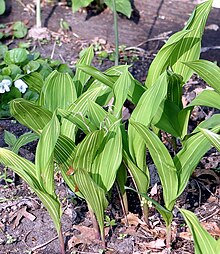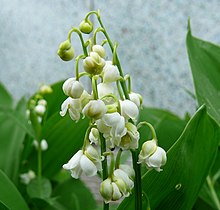Description
Convallaria majalis is a herbaceous perennial plant that forms extensive colonies by spreading underground stems called rhizomes. New upright shoots are formed at the ends of stolons in summer,[4] these upright dormant stems are often called pips.[5] These grow in the spring into new leafy shoots that still remain connected to the other shoots under ground, often forming extensive colonies. The stems grow to 15–30 cm tall, with one or two leaves 10–25 cm long; flowering stems have two leaves and a raceme of 5–15 flowers on the stem apex.
The flowers have six white tepals (rarely pink), fused at the base to form a bell-shape, 5–10 mm diameter, and sweetly scented; flowering is in late spring, in mild winters in the Northern Hemisphere it is in early March. The fruit is a small orange-red berry 5–7 mm diameter that contains a few large whitish to brownish colored seeds that dry to a clear translucent round bead 1–3 mm wide. Plants are self-sterile, and colonies consisting of a single clone do not set seed.[6]
Distribution
Convallaria majalis is a native of Europe, where it largely avoids the Mediterranean and Atlantic margins. An eastern variety, C. majalis var. keiskei occurs in Japan and parts of eastern Asia. A limited native population of C. majalis var. montana occurs in the Eastern United States.[8] There is, however, some debate as to the native status of the American variety.
Like many perennial flowering plants, C. majalis exhibits dual reproductive modes by producing offspring asexually by vegetative means and by seed, produced via the fusion of gametes.
Ecology
Convallaria majalis is a plant of partial shade, and mesophile type that prefers warm summers. It likes soils that are silty or sandy and acid to moderately alkaline, with preferably a plentiful amount of humus. The Royal Horticultural Society states that slightly alkaline soils are the most favoured. It is an Euroasiatic and suboceanic species that lives in mountains up to 1,500 m altitude.
Convallaria majalis is used as a food plant by the larvae of some Lepidoptera species including the grey chi. Adults and larvae of the leaf beetle Lilioceris merdigera are also able to tolerate the cardenolides and thus feed on the leaves.
Taxonomy
There are three varieties that have sometimes been separated out as distinct species or subspecies by some botanists.[15]
- Convallaria majalis var. keiskei – from China and Japan, with red fruit and bowl-shaped flowers (now widely cited as Convallaria keiskei)[6][16]
- C. majalis var. majalis – from Eurasia, with white midribs on the flowers
- C. majalis var. montana – from the United States, with green-tinted midribs on the flowers
Convallaria transcaucasica is recognised as a distinct species by some authorities, while the species formerly called Convallaria japonica is now classified as Ophiopogon japonicus.[16]
Cultivation
Convallaria majalis is widely grown in gardens for its scented flowers and ground-covering abilities in shady locations. It has gained the Royal Horticultural Society's Award of Garden Merit. (confirmed 2017).] In favourable conditions it can form large colonies.
Various kinds and cultivars are grown, including those with double flowers, rose-colored flowers, variegated foliage and ones that grow larger than the typical species.
- C. majalis 'Albostriata' has white-striped leaves
- C. majalis 'Green Tapestry', 'Haldon Grange', 'Hardwick Hall', 'Hofheim', 'Marcel', 'Variegata' and 'Vic Pawlowski's Gold' are other variegated cultivars[
- C. majalis 'Berlin Giant' and C. majalis 'Géant de Fortin' (syn. 'Fortin's Giant') are larger-growing cultivars
- C. majalis 'Flore Pleno' has double flowers.
- C. majalis 'Rosea' sometimes found under the name C. majalis var. rosea, has pink flowers.
Traditionally Convallaria majalis has been grown in pots and winter forced to provide flowers during the winter months, both for as potted plants and as cut flowers.
Chemistry
All parts of the plant are highly poisonous, including the red berries which may be attractive to children. If ingested—even in small amounts—the plant can cause abdominal pain, vomiting, reduced heart rate, blurred vision, drowsiness, and red skin rashes.
Roughly different cardiac glycosides (cardenolides) have been found in the plant, including among others:
|
The plant also contains saponins. Although deadly, the plant has been used as a folk remedy in moderate amounts, and is currently used by herbalists as a restricted herbal remedy. It also contains the unusual, poisonous amino acid azetidine-2-carboxylic acid.
The odor of lily of the valley, specifically the ligand bourgeonal, attracts mammalian sperm. The 2003 discovery of this phenomenon prompted research into odor reception, but a 2012 study demonstrated instead that at high concentrations, bourgeonal imitated the role of progesterone in stimulating sperm to swim (chemotaxis), a process unrelated to odor reception.
Uses
Perfume
In 1956, the French firm Dior produced a fragrance simulating lily of the valley, which was Christian Dior's favorite flower. Diorissimo was designed by Edmond Roudnitska. Although it has since been reformulated, it is considered a classic.
Other perfumes imitating or based on the flower include Henri Robert's Muguet de Bois (1936), Penhaligon's Lily of the Valley (1976), and Olivia Giacobetti's En Passant (2000).








No comments:
Post a Comment